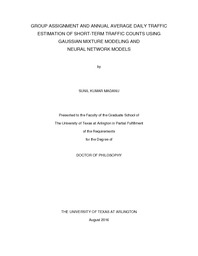
ATTENTION: The works hosted here are being migrated to a new repository that will consolidate resources, improve discoverability, and better show UTA's research impact on the global community. We will update authors as the migration progresses. Please see MavMatrix for more information.
Show simple item record
| dc.contributor.advisor | Mattingly, Stephen P. | |
| dc.creator | Madanu, Sunil Kumar | |
| dc.date.accessioned | 2016-10-25T20:48:24Z | |
| dc.date.available | 2016-10-25T20:48:24Z | |
| dc.date.created | 2016-08 | |
| dc.date.issued | 2016-09-13 | |
| dc.date.submitted | August 2016 | |
| dc.identifier.uri | http://hdl.handle.net/10106/26176 | |
| dc.description.abstract | The grouping of similar traffic patterns and cluster assignment process represent the most critical steps in AADT estimation from short-term traffic counts. Incorrect grouping and assignment often become a significant source of AADT estimation errors. For instance, grouping a commuter traffic trend pattern into a recreational traffic trend may produce an erroneous AADT value. The traditional knowledge-based methods, often aided with visual interpretation, introduce subjective bias while grouping traffic patterns. In addition, the grouping requires personnel resources to process large amounts of data and remains inefficient with unapparent traffic patterns. The functional class grouping, a traditional method, also produces larger errors. Under limited resources and constraints, better methods and techniques may group sites with similar characteristics.
The study uses Gaussian Mixture Modeling (GMM) for clustering and an enhanced neural network model (OWO-Newton or ONN) for classification of continuous count data. The researchers compare this modified approach with volume factor grouping and a traditional approach. The study uses Automatic Traffic Recorder (ATR) data from the Oregon Department of Transportation (ODOT) as a comparative case study. Overall, the proposed two-step approach, GMM-ONN, exhibits improved performance. The study observes an error difference of 6% to 27%, which is statistically significant at 5 percent level, between the GMM-ONN and other methods. The GMM-ONN method produces less than five percent error for urban interstates and less than ten percent for urban arterials and freeways. The study method meets the FHWA recommended AADT forecasting error of less than ten percent for commuter patterns. The GMM-ONN also produces less error when compared to studies based on the national average and Minnesota and Florida DOT count data. The lower AADT estimation errors and its distribution show an effective and reliable approach for AADT estimation using short-term traffic counts. Moreover, the lower standard deviation of errors shows the satisfactory accuracy of the AADT estimates. The study recommends the improved two-step process due to its accuracy, economical approach by using daily patterns, and ability to meet the agency’s need for a low-cost traffic counting program. The GMM-ONN method not only minimizes judgment errors but also supplements the FHWA guidelines on recommending clustering techniques for grouping the traffic patterns. | |
| dc.format.mimetype | application/pdf | |
| dc.language.iso | en_US | |
| dc.subject | Gaussian mixture model | |
| dc.subject | GMM | |
| dc.subject | Automatic traffic recorder | |
| dc.subject | ATR | |
| dc.subject | AADT | |
| dc.subject | Short-term traffic counts | |
| dc.subject | Clustering | |
| dc.subject | Traffic patterns | |
| dc.subject | Grouping | |
| dc.subject | Neural networks | |
| dc.subject | AUC | |
| dc.subject | Accuracy | |
| dc.subject | QDA | |
| dc.subject | Traffic counts | |
| dc.subject | Traffic monitoring | |
| dc.title | Group Assignment and Annual Average Daily Traffic Estimation of Short-term Traffic Counts Using Gaussian Mixture Modeling and Neural Network Models | |
| dc.type | Thesis | |
| dc.degree.department | Civil Engineering | |
| dc.degree.name | Doctor of Philosophy in Civil Engineering | |
| dc.date.updated | 2016-10-25T20:50:31Z | |
| thesis.degree.department | Civil Engineering | |
| thesis.degree.grantor | The University of Texas at Arlington | |
| thesis.degree.level | Doctoral | |
| thesis.degree.name | Doctor of Philosophy in Civil Engineering | |
| dc.type.material | text | |
Files in this item
- Name:
- MADANU-DISSERTATION-2016.pdf
- Size:
- 2.399Mb
- Format:
- PDF
This item appears in the following Collection(s)
Show simple item record


